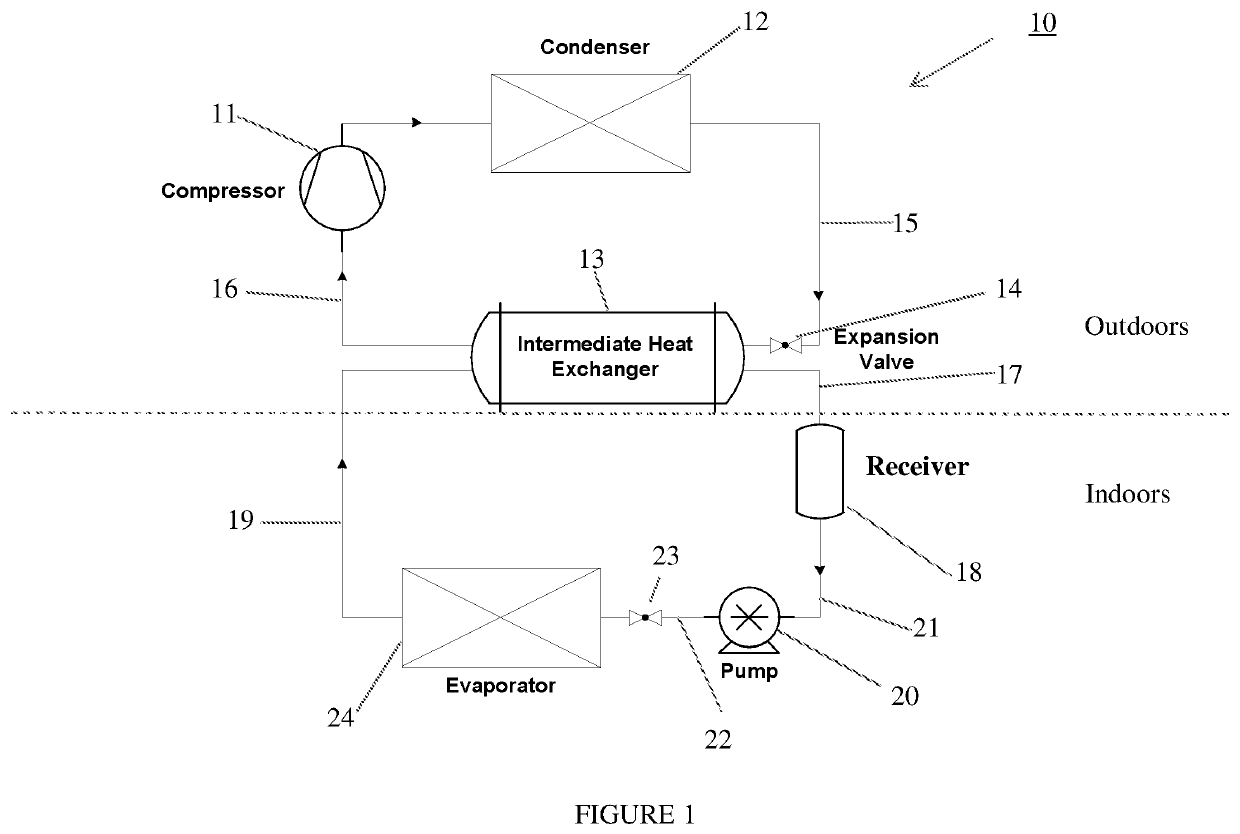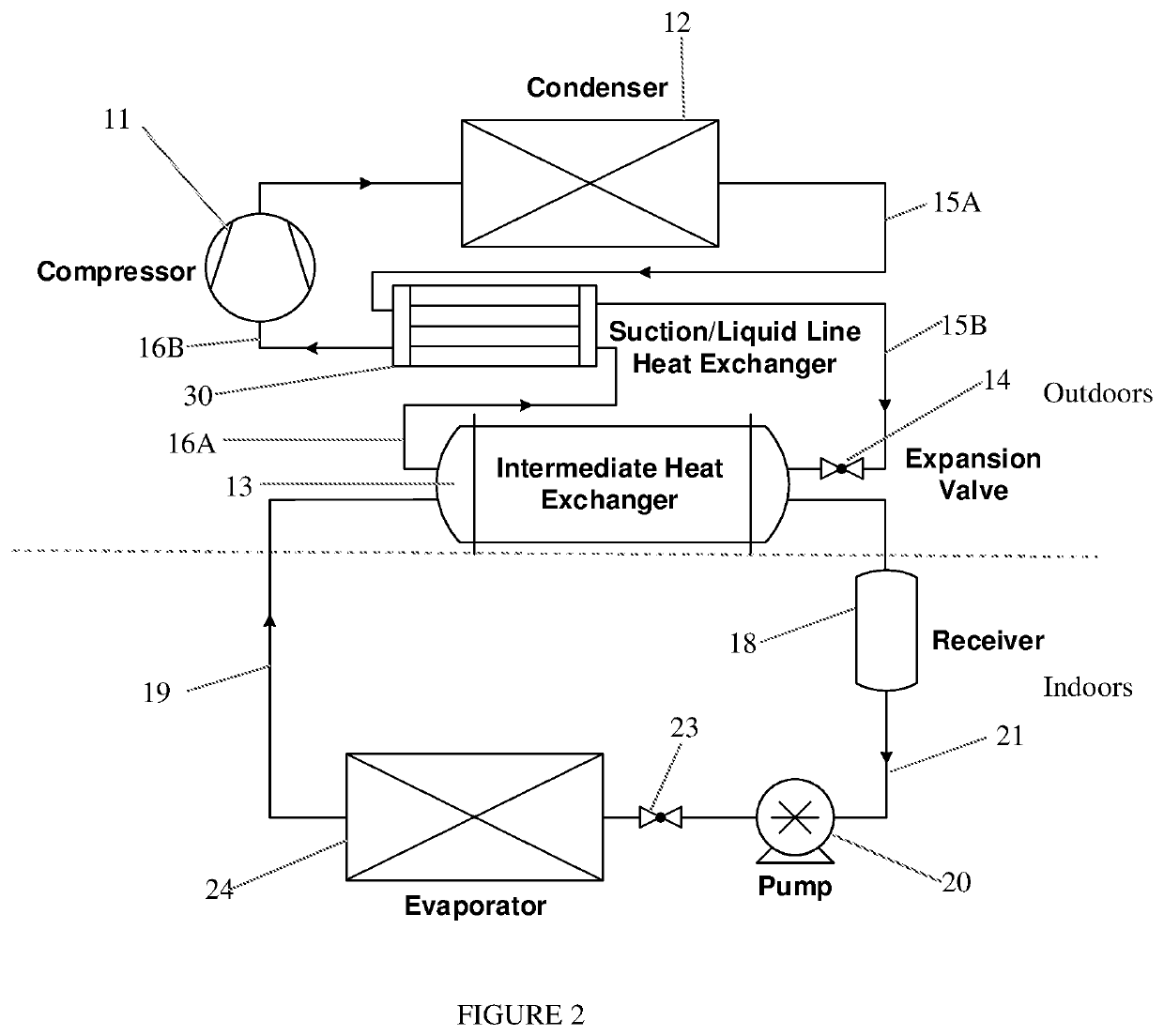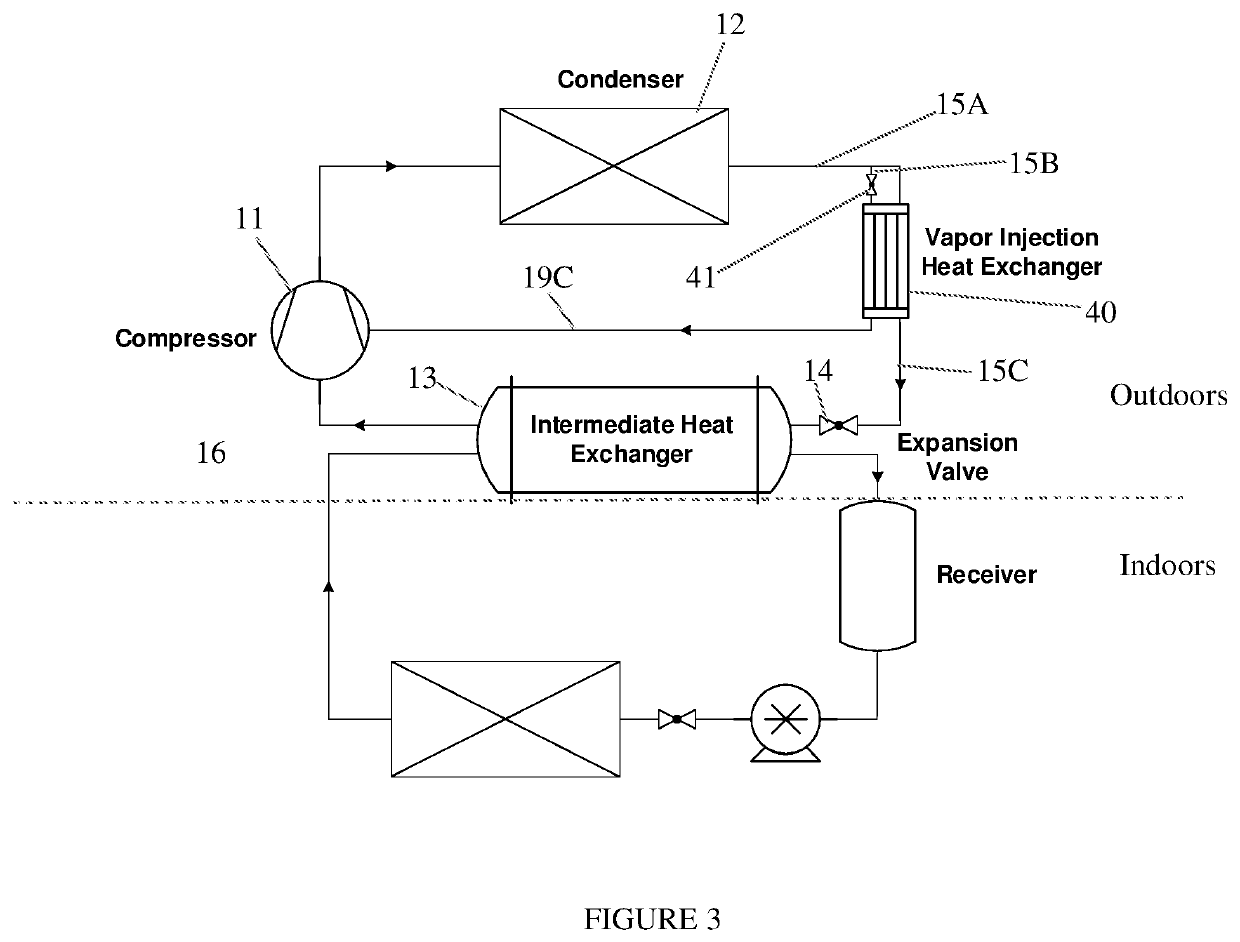Air conditioning systems and methods
a technology of air conditioning system and air conditioning chamber, which is applied in the direction of refrigeration components, mechanical equipment, light and heating equipment, etc., can solve the problems of high disadvantage and/or preclude the use of humans or other animals in confined and/or closed locations, and achieve the effect of low flammability and low toxicity
- Summary
- Abstract
- Description
- Claims
- Application Information
AI Technical Summary
Benefits of technology
Problems solved by technology
Method used
Image
Examples
example 1a
Example 1A (FIG. 1) Operating Conditions
[0066]A system configured as illustrated herein in FIG. 1 is operated according to the following operating parameters using a series of different first (outdoor) and second (indoor) refrigerants:
[0067]1. Condensing temperature=45° C., corresponding outdoor ambient temperature=35° C.
[0068]2. Condensing Temperature—Ambient Temperature=10° C.
[0069]3. Expansion device sub-cooling=5.0° C.
[0070]4. Evaporating temperature=7° C., corresponding indoor room temperature=27° C.
[0071]5. Evaporator Superheat=0.0° C. (flooded)
[0072]6. Intermediate Heat Exchanger Superheat=5.0° C.
[0073]7. Isentropic Efficiency=72%
[0074]8. Volumetric Efficiency=100%
[0075]9. Difference of saturation temperatures intermediate heat exchanger=5° C.
The results are provided (with percentages for blends shown in weight %) in Table 1A below:
[0076]
TABLE 1ASecondFirst (Outdoor)(Indoor)GWPGWPCa-RefrigerantRefrigerantPrimarySecondarypacityEfficiencyR410ANA1924100%100%PropaneR1233zd31100%9...
example 2a
Example 2A (FIG. 2) Operating Conditions
[0084]A system configured as illustrated herein in FIG. 2 is operated according to the following operating parameters using a series of different first (outdoor) and second (indoor) refrigerants:
[0085]1. Condensing temperature=45° C., corresponding outdoor ambient temperature=35° C.
[0086]2. Condensing Temperature—Ambient Temperature=10° C.
[0087]3. Expansion device sub-cooling=5.0° C.
[0088]4. Evaporating temperature=7° C., corresponding indoor room temperature=27° C.
[0089]5. Evaporator Superheat=0.0° C. (flooded)
[0090]6. Intermediate Heat Exchanger Superheat=5.0° C.
[0091]7. Isentropic Efficiency=72%
[0092]8. Volumetric Efficiency=100%
[0093]9. Difference of saturation temperatures intermediate heat exchanger=5° C.
The results are provided (with percentages for blends shown in weight %) in Table 2A below:
[0094]
TABLE 2APrimarySecondaryGWPGWPEfficiency@Efficiency@Efficiency@Efficiency@Efficiency@RefrigerantRefrigerantPrimarySecondary0% effect.35% eff...
example 2b
Example 2B (FIG. 2)—Alteration of Condenser Temperature
[0095]A system configured as illustrated herein in FIG. 2 is operated according to the same operating parameters as Example 2A using a series of different first (outdoor) and second (indoor) refrigerants, except that the condensing temperature is adjusted for each blend in order to obtain an efficiency that substantially matches the efficiency achieved according to Comparative Example 1. The results are provided in Table 2B below:
[0096]
TABLE 2BTcond (° C.)Tcond (° C.)Tcond (° C.)Tcond (° C.)Tcond (° C.)PrimarySecondaryGWPGWP@ 0%@ 35%@ 55%@ 75%@ 85%RefrigerantRefrigerantPrimarySecondaryeffect.effect.effect.effect.effect.R410A192445.045.045.045.045.0PropaneR1233zd3141.741.942.142.342.4R1234yfR1233zd1141.241.842.242.642.8R1234zeR1233zd1142.242.743.043.343.5R32 / R1234yfR1233zd69141.141.641.942.342.5(10.0% / 90.0%)R32 / R1234zeR1233zd69142.142.542.843.143.3(10.0% / 90.0%)R32 / R1234yfR1233zd150141.041.241.441.641.7(22.0% / 79.0%)R32 / R1234zeR123...
PUM
 Login to View More
Login to View More Abstract
Description
Claims
Application Information
 Login to View More
Login to View More - R&D
- Intellectual Property
- Life Sciences
- Materials
- Tech Scout
- Unparalleled Data Quality
- Higher Quality Content
- 60% Fewer Hallucinations
Browse by: Latest US Patents, China's latest patents, Technical Efficacy Thesaurus, Application Domain, Technology Topic, Popular Technical Reports.
© 2025 PatSnap. All rights reserved.Legal|Privacy policy|Modern Slavery Act Transparency Statement|Sitemap|About US| Contact US: help@patsnap.com



